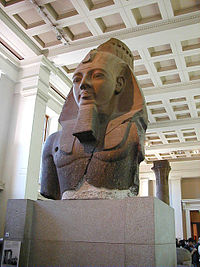Younger Memnon
This article includes alist of references,related reading,orexternal links,but its sources remain unclear because it lacksinline citations.(December 2023) |
| Younger Memnoncolossalfigure | |
|---|---|
 The Younger Memnon (Ramesses II) | |
| Material | Granite |
| Size | H: 267 cm (105 in) W: 203 cm (80 in) |
| Created | c. 1270 BC |
| Period/culture | 19th Dynasty |
| Place | Ramesseum,Doorway |
| Present location | Room 4,British Museum, London |
| Identification | EA 19 |
TheYounger Memnonis anAncient Egyptianstatue, one of two colossalgranitestatues from theRamesseummortuarytempleinThebes,Upper Egypt.It depicts theNineteenth DynastyPharaohRamesses IIwearing theNemeshead-dress with acobra diademon top. The damaged statue has since been separated from its upper torso and head. These sections can now be found in the British Museum. The remainder of the statue remains in Egypt. It is one of a pair that originally flanked the Ramesseum's doorway. The head of the other statue is still found at the temple.
Description
[edit]The Younger Memnon is 2.7 metres (8 ft 10 in) high × 2 metres (6 ft 7 in) wide (across the shoulders). It weighs 7.25 tons and was cut from a single block of two-coloured granite. There is a slight variation of normal conventions in that the eyes look down slightly more than usual, and to exploit the different colours (broadly speaking, the head is in one colour, and the body another).
Acquisition
[edit]Belzoni
[edit]

Napoleon's men tried but failed to dig and remove it to France during his 1798expeditionthere, during which he did acquire but then lost theRosetta Stone.It was during this attempt that the hole on the right of the torso (just above Ramesses's right nipple) is said to have been made.

Following an idea mentioned to him by his friendJohann Ludwig Burckhardtof digging the statue and bringing it to Britain, the British Consul GeneralHenry Salthired the adventurerGiovanni BelzoniinCairoin 1815 for this purpose. Using his hydraulics and engineering skills, it was pulled on wooden rollers by ropes to the bank of theNileoppositeLuxorby hundreds of workmen. However, no boat was yet available to take it up to Alexandria and so Belzoni carried out an expedition to Nubia, returning by October. With French collectors also in the area possibly looking to acquire the statue, he then sent workmen toEsnato gain a suitable boat and in the meantime carried out further excavations in Thebes. He finally loaded the products of these digs, plus the Memnon, onto this boat and got it to Cairo by 15 December 1816. There he received and obeyed orders from Salt to unload all but the Memnon, which was then sent on toAlexandriaand London without him.
Anticipated by Shelley's poem "Ozymandias",the head arrived in 1818 onWeymouthin Deptford. In London it acquired its name "The Younger Memnon", after the "Memnonianum" (the name in classical times for theRamesseum– the two statues at the entrance of the mortuary temple ofAmenhotep IIIwere associated withMemnonin classical times, and are still known as theColossi of Memnon.TheBritish Museumsculpture and its pair seem to have either been mistaken for them or suffered a similar misnaming).
British Museum
[edit]
It was later acquired from Salt in 1821 by the British Museum and was at first displayed in the oldTownleyGalleries (now demolished) for several years, then installed (using heavy ropes and lifting equipment and with help from theRoyal Engineers) in 1834 in the new Egyptian Sculpture Gallery (now Room 4, where it now resides). The soldiers were commanded by aWaterlooveteran, Major Charles Cornwallis Dansey, lame from a wound sustained there, who therefore sat whilst commanding them. On its arrival there, it could be said to be the first piece of Egyptian sculpture to be recognized as a work of art rather than a curiosity low down in the chain of art (with ancient Greek art at the pinnacle of this chain). It is museum number EA 19.[1]

In February 2010, the statue was featured as object 20 inA History of the World in 100 Objects,aBBC Radio 4programme by British Museum directorNeil MacGregor.[2][3]
References
[edit]- ^"The Younger Memnon › The British Museum".Britishmuseum.org.Retrieved16 November2015.
- ^"A History of the World – Object: Statue of Ramesses II".BBC.Retrieved6 June2010.
- ^"Colossal bust of Ramesses II, the 'Younger Memnon' › The British Museum".Britishmuseum.org. 14 May 2010.Retrieved6 June2010.
Sources
[edit]- 3D model of the Younger Memnon via photogrammetric survey
- Encyclopaedic.net – extracts from Belzoni's account
- Publications
- James, T. G. H.; Davies, W. V. (1983),Egyptian Sculpture,Harvard University Press, p. 41,ISBN978-0-674-24161-9
- G. Belzoni, Narrative of the operations and recent discoveries within the pyramids, temples, tombs, and excavations in Egypt and Nubia I (London, John Murray, 1822), pp. 61–80
- S. Quirke and A.J. Spencer, The British Museum book of ancient Egypt (London, The British Museum Press, 1992), pp. 126–7
- Albert M. Lythgoe,'Statues of the Goddess Sekhmet',The Metropolitan Museum of Art BulletinVol. 14, No. 10, Part 2 (Oct., 1919), pp. 1+3-23
- Stephanie Moser,Wondrous Curiosities: Ancient Egypt at the British Museum (University of Chicago Press, 2006),ISBN0-226-54209-2
